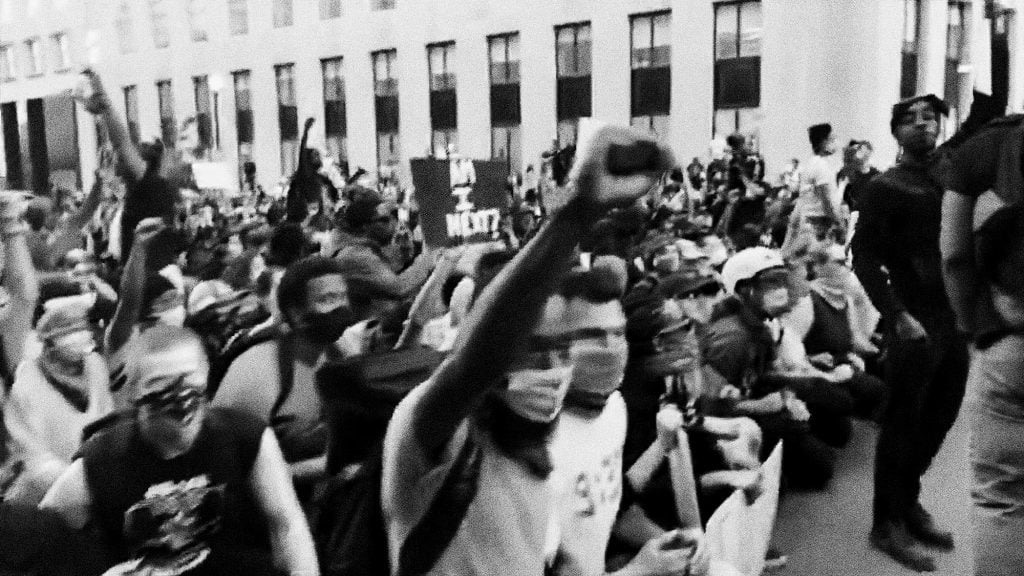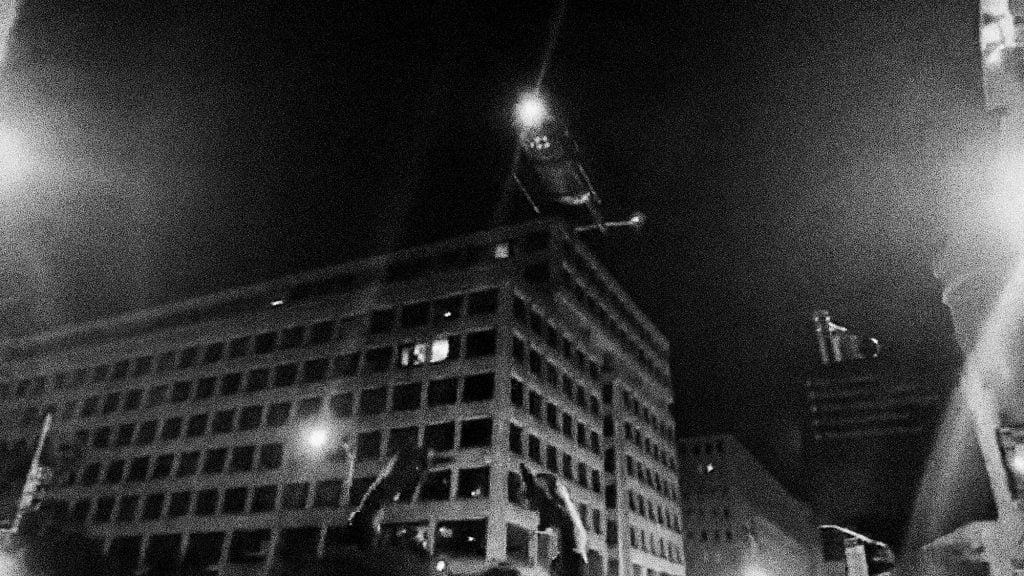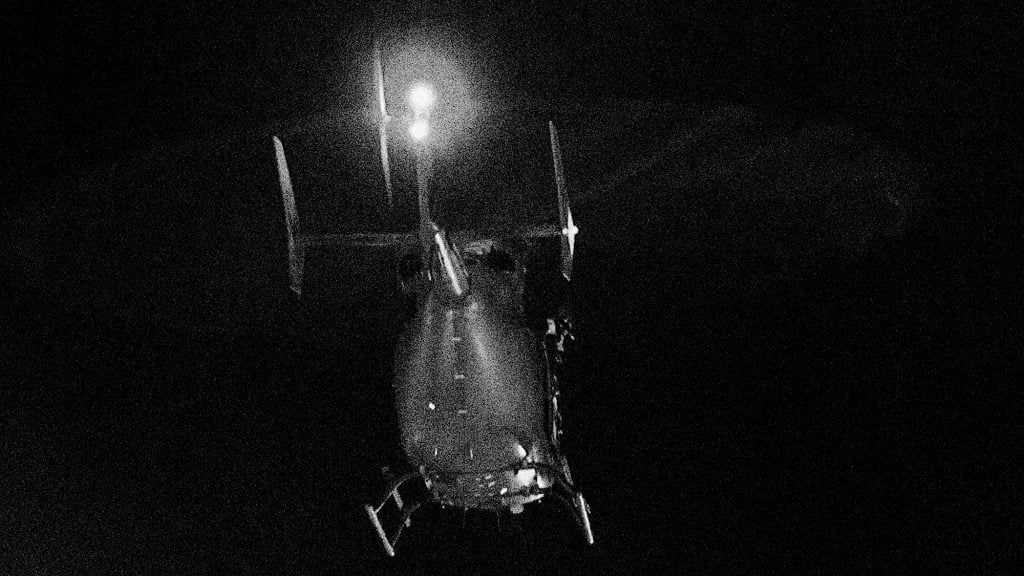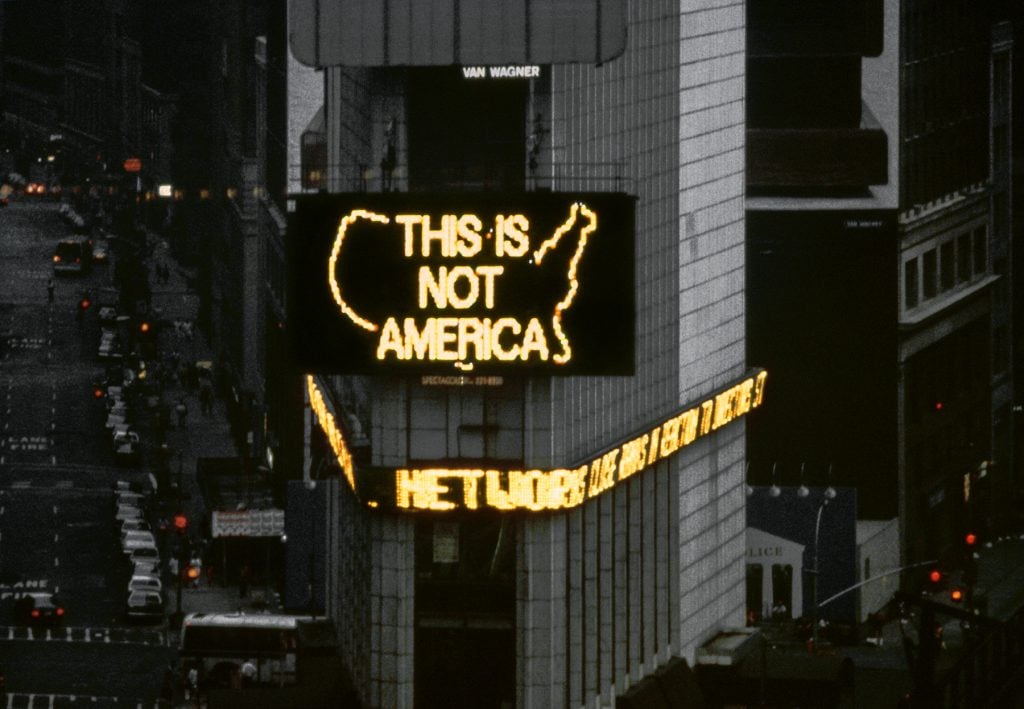Politics
‘This Work Is About the Abuse of Power’: Alfredo Jaar on His Immersive Black Lives Matter Protest Piece at the Whitney Biennial
The installation uses massive fans to recreate the chaos of the events of June 1, 2020, in Washington, D.C.

The installation uses massive fans to recreate the chaos of the events of June 1, 2020, in Washington, D.C.

Sarah Cascone

On the sixth floor at New York’s 2022 Whitney Biennial, the walls and ceiling are painted black, with matching wall-to-wall carpeting. The darkness sets a somber tone befitting Alfredo Jaar’s video installation 06.01.2020 18.39 (2022), tucked away inside a black-box gallery one can only enter when the green light above the door is on.
That’s because the five-minute piece is meant to be watched from start to finish, allowing the viewer to experience the fullness of the artist’s vision, which includes special effects that wouldn’t be out of place in a 4DX movie screening.
Jaar, who hails from Chile, has pieced together videos of Black Lives Matter protests in Washington, D.C., on June 1, 2020—six days after police officer Derek Chauvin murdered George Floyd, an unarmed Black man in Minneapolis—to recreate the sense of chaos and danger on the ground that day.
The backstory to the harrowing footage, showing exploding tear- gas canisters and National Guard helicopters bearing down on defenseless citizens, of course, is that then-President Donald Trump had ordered the dispersal of protesters ahead of the city’s 7 p.m. curfew, so that he could stage a photo op in front of St. John’s Church, holding up a Bible.
At home in New York, Jaar could only watch in disbelief as the events of that day unfolded on television. Although international human-rights law prohibits the militarized use of helicopters, one swooped as low as 100 feet above the ground. We spoke to the artist about what inspired him to turn a police attack on peaceful demonstrators into art, and the challenges of creating the piece.

Still from Alfredo Jaar, 06.01.2020 18.39 (2022). Courtesy of the artist and Galerie Lelong, New York.
What was your experience of the 2020 Black Lives Matter protests?
I was like everyone else; I had been confined at home. I was looking at the state of the world, and this extraordinary inequity that was becoming more visible than ever. When this movement started, I was galvanized. I started following it from afar. I went to a few marches in New York, but after the events of June 1.
The June 1 event, I followed it online and on television. I was shocked, of course, like everybody else. I couldn’t believe what I was witnessing. But maybe I should tell you about my relationship to helicopters.
Coming from Chile, from Latin America, helicopters are for me a synonym for death flights. In Chile, hundreds of bodies were dropped from helicopters into the ocean by the military dictatorship. In Argentina, it was thousands of bodies.
Helicopters for me have this very, very dark connotation. So when I saw the helicopters being used in D.C., totally illegally, to disperse the peaceful protesters, I was totally shocked and enraged. In that moment, I decided to do a piece. And eventually, I decided this was going to be the work for the biennial.
How did you go about working on this project?
I felt that no one was taking the fact of the helicopter seriously. I realized it had been extremely dangerous. The helicopters were very, very close to the top of the buildings. If one of them had touched a building, it would have been a huge tragedy, killing hundreds of people.
I had seen a couple of shots from media organizations, but they were only 10 or 15 seconds long, so I started searching online for more footage. We found approximately three hours of footage of that event from different witnesses who were there, protesters, activists, and other people.
I spent months looking at this footage. It was extremely difficult, but in the end I had enough to tell the story of that day.
I wanted to structure it in three parts. The first part is the peaceful protest. The second part was when they start shooting off tear gas, stun grenades, and rubber bullets. And the third part is the helicopters. That was the footage I was looking for. And when I found it, I started editing.

Still from Alfredo Jaar, 06.01.2020 18.39 (2022). Courtesy of the artist and Galerie Lelong, New York.
How did you cut the final film?
As you know very well, the attention span of people in a museum or gallery is very, very short—scientifically, I think it’s three seconds per artwork. Artists work for years in the studio, and we show a work somewhere and people walk past it in three seconds. It’s really frustrating.
I wanted to hold people in in front of the piece, so I knew it couldn’t last more than five minutes.
Because the footage was shot with different types of cameras, different types of movement, different points of view, we converted everything to black and white. I exaggerated the contrast. I wanted a strong black and white, and I wanted grainy. That gives a homogenous look to the entire film, even though it was shot by different people.
Most of it was from a young activist from L.A. called Jay Jay Thakar, with other footage from the Associated Press and a couple of European agencies. I contacted everyone and I purchased the rights. I’m not an artist who appropriates the work of others; I wanted to pay for the rights. That’s how the work was born.
Were there any difficulties in creating the installation, which uses fans to mimic the strong gusts of winds created by the helicopter?
We needed fans that were powerful, but could be controlled by a computer, so we had to do some research and testing. We found this fan that is used for film effects, people with their hair in the wind, and so on. It is very powerful and makes a huge sound, which was very interesting. I would have used a dozen fans, but these fans were very expensive and we could only afford six. They had to be installed overhead, because that’s where the helicopters were. We created a grid with the fans, and if you stand directly underneath the fans, you feel it very strongly.
With the fans and the sounds, I wanted to make the audience feel in their own bodies the adrenaline, the chaos, and the fear of the protesters, to identify with them. And I wanted the audience to witness the protesters’ insistence that they had the right to be there.
That was the most beautiful thing for me. When I look at the footage you can see in their body language that they were saying, “We have the right to be here—it is our right.”
For me, ultimately, this work is about the abuse of power. That’s what it is.
I wanted to show how a group of peaceful protesters were brutalized by their own government, and how, in spite of this, they resisted gracefully, defiantly. They endured it. I realized I was witnessing some kind of choreography of resistance, resisting the abuse of power. That’s what I liked about the footage we found, and the way we treated it with slow motion and so on.

Still from Alfredo Jaar, 06.01.2020 18.39 (2022). Courtesy of the artist and Galerie Lelong, New York.
Did you ever consider showing what happened next, with Trump at the church, explaining what prompted this terrible show of military force?
I didn’t feel that there was a need to display him whatsoever.
How did you feel seeing these protests going on across the whole nation in response to the deaths of George Floyd and so many others?
I was really impressed. I moved to this country in 1982, and I was always shocked by the level of racism I’d see. Maybe I saw it more clearly than others because I was an outsider. I had studied U.S. history, and I thought the civil rights movement and Martin Luther King Jr. had made a big difference—and they did, but not enough to say that there’s no racism.
The first few years, I was always looking out my window and thinking, “Where’s the revolution? Where’s the people protesting? How is this possible?” But after awhile, you get used to it, because everyone is used to it, and no one does anything.
We have to give credit Patrisse [Cullors], Alicia [Garza], and Opal [Tometi], the three founders of Black Lives Matter—this extraordinary movement grew and and it grew. It has made an extraordinary difference, not only in the political scene, but also in the cultural scene.
And parallel to that, I was observing protests happening in Chile, where I am from. It’s an interesting coincidence. I’m sure in this country, most people were not aware of it, but Chilean students were also marching and protesting in the streets.
The result of those protests was extraordinary. Right now, there are 155 people elected by Chileans who are writing new constitution for Chile. This constitutional assembly had to have parity, so we have exactly half women and half men, and we also have 17 members of different indigenous groups in Chile who were never represented before.
These 155 people, there are artists, there are intellectuals, there are scientists, there are lawyers—people from different disciplines, and the youngest is 21 years old. They are writing a constitution that will be submitted to a referendum. That was the effect of those protests—and the grand finale came recently when Chile elected a very young president, only 35 years old. [Gabriel Boric] was one of the students protesting in the street, and now he’s president.
It was really an extraordinary revolution that we were witnessing in Chile, coincidentally at the same time that this was happening here.
Of course, it’s not enough. It’s never enough, but I have never been so hopeful regarding the possibility of change. With this work, I wanted to mark that moment.

Alfredo Jaar, A Logo for America (1987) from “Messages to the Public,” Public Art Fund, Times Square, New York. Courtesy of the artist.
And how did you come to show the work at the biennial?
First, the curators [Adrienne Edwards and David Breslin] wrote to me inviting me, and then we had a Zoom meeting. I asked them about the concept of the biennial. They explained how they wanted to create a portrait of the country at this moment.
It’s my first Whitney Biennial, even though I’ve been here for 40 years. Until recently, the biennial was only open to U.S. citizens. The last few editions, it’s been open to citizens of other countries living in the States, which is when I started to qualify. And this biennial has done something even more extraordinary: They have Mexican citizens who live in Mexico. This is quite extraordinary.
Now, finally, the name Whitney Museum of American Art is going to reach its full meaning. America is a continent. I feel American. Soy un Americano. Latin Americans and Canadians, they all feel American. In the daily language of this country, people say “American” all the time: God bless America, welcome to America, blah, blah, blah. By doing so, they are erasing the rest of the continent from the map.
That’s why I created my work A Logo for America in 1987, where I criticized the use of the word “America” to refer only to the United States. I’m aware of this issue all the time.
So with this biennial, when we say Whitney Museum of American Art, it will finally mean America the continent. It should mean that—or it should be another name, Whitney Museum of United States Art. Perhaps the next curators will start inviting artists from the entire continent, which would be marvelous.
“Whitney Biennial 2022: Quiet as It’s Kept” is on view at the Whitney Museum of American Art, 99 Gansevoort Street, New York, April 6–September 5, 2022.